Planning for Parklands
In his 1837 Plan of Adelaide Surveyor-General Colonel William Light created a grid pattern of streets, bounded by terraces to the north, south, east and west and surrounded by park lands. This was a visionary plan for a city and reflected up-to-date views on the importance of fresh air and open space in urban areas. It is thought to be a unique design feature, recognised in 2008 by the inclusion of the Adelaide Parklands on the National Heritage List. In all the parklands comprised some 931ha (2300 acres) in 1837, although subsequent building reduced them to about 689ha (1702 acres).
Light was excited by the possibilities of the wide plain that stretched between the coast and the Mt Lofty Ranges and determined on this site for Adelaide in December 1836, despite its distance from the coast. The land Light saw in 1836 already resembled an ‘English park’ – a point which struck many early European settlers. Native grasses grew tall and thick, reaching to the horses’ manes in parts, while tall Eucalpyts dotted the landscape and fringed the River Torrens. Elsewhere grew Acacia (wattle), Sheoak and many flowering plants. Native birds and animals were in abundance. Animals included kangaroos, wallabies, possums, bilbies, native rats and many varieties of lizards and snakes – some 40 different species of mammals and 56 species of reptiles in all. Among the estimated 285 species of birds were parrots, lorikeets, magpies, kookaburras, black swans, several native duck species and many others. Birds survived the advent of Europeans better than mammals. It is thought that some 20 of the original 40 mammal species are now extinct, while about 7% of native birds are lost. The reptiles survived best of all.
Original Inhabitants
The Kaurna people were the original inhabitants of the land that became the site of Adelaide, and regularly engaged in hunting, fishing and foraging activities within the area that now comprises the South Parklands. Animal food sources included a vast variety of mammals, reptiles and birds, while several different plant species—among them Minno (Golden Wattle), Walyo (Yam Daisy), Warnpo (Bulrush root) and Pityarra (Marshmallow Plant root)—were consumed and/or employed in the manufacture of useful items such as nets and baskets. The Kaurna also utilised different species of Eucalypt until the arrival of Europeans, after which the existing old-growth trees were quickly decimated for building material and firewood.
Aboriginal people also utilised the land that became the South Parklands as a camping site during the prehistoric and early colonial periods. For example, Ngarrindjeri often stopped in the area when journeying overland from the Coorong to Pattawilya (Glenelg). On occasion, friction between different Aboriginal groups erupted into open warfare, as occurred within the South Parklands when a major battle occurred between Kaurna and a group of Ngarrindjeri from Goolwa. In a conversation with anthropologist Norman Tindale, Kaurna man Joe Chalk related that during the altercation the ‘Adelaide [Kaurna] people used no shields or throwing sticks, but just dodged and ducked to avoid their opponents’ missiles’. Mr. Chalk also observed that Ngarrindjeri who took part in the battle ‘carried woomeras (spear-throwers)’.
Early European Use
The earliest recorded European use of Adelaide’s South Parklands was as a firing range for training militia volunteers in the use of rifles. Use of the range also extended to archery practice, and officially commenced in October 1859. Targets were affixed to a series of ‘butts’, large earthen mounds positioned at the end of narrow, linear clearings 1000 yards in length. By 1860, the Adelaide Regiment of Volunteer Rifles were regularly training and exercising in the use of firearms. However, the proximity of the range to the city’s expanding population posed potential hazards for those who used the parklands for leisure activities, or as a short cut. In one well-documented instance in November 1859, fourteen-year-old Master Ebworth stooped to pick up a piece of wheat at the exact moment an errant round from the nearby range tore through his hat and knocked it to the ground. Ebworth later stated he hadn’t heard the report of a gun, but did note the whizzing noise of the bullet as it passed over his head and struck his hat.
This and other occasional near-misses prompted the alteration and enlargement of the range in autumn 1861. Markers were placed at intervals, and each butt was expanded, sloped on all sides, and accessed via steps. A ‘retiring room’ constructed for those not shooting offered an excellent vantage point from which to observe the goings-on within the range. Initially, these improvements were considered a boon for Adelaide-based militia volunteers, who no longer had to travel to sparsely-populated coastal communities such as Glenelg, Brighton or Semaphore for long-range rifle practice. However, by June 1877 the range was again considered a hazard and nuisance—particularly by residents of Unley and Goodwood, who petitioned Colonial Secretary Henry Ayers to have it moved elsewhere. By April of the following year, stone components of the range were dismantled and reused in the construction of cattle market sheds at North Terrace. The butts persisted a few decades longer, but were eventually reduced through borrowing of their earthen matrix for planting soil and landscaping material. They were completely removed by 1903. Today, the only physical evidence of the range is a Former Rifle Butts Memorial, located in Walyu Yarta (Park 21) adjacent to Sir Lewis Cohen Drive.
In 1881, an 850,000 gallon (3.86 mega-litres) reservoir was constructed in Tuthangga (Park 17) near the intersection of South and East Terraces. The reservoir, two-thirds of which was buried underground, supplied Glenelg with water and remained in use until 1928. It was completely filled and covered over with soil in 1982. Today, it appears as a large earthen mound bounded on its southern side by a remnant section of wrought-iron fence. A cast-iron benchmark, one of 30 located within the Adelaide metro area and once used to monitor the flow of the city’s water and sewerage, is located immediately adjacent to the reservoir.
Green-spaces
Elm Avenue Carriageway is a beautiful English Elm-lined path that originates at Hutt Street and extends southeast through Tuthangga (Park 17) in the eastern extremity of the South Parklands. It was featured in John Ednie Brown’s Report on a System of Planting for the Adelaide Park Lands, an influential work in the history of landscape architecture in Australia. Brown was a Scottish forest conservator commissioned by Adelaide Mayor William Buik to draft the report in 1880. Its subsequent popularity earned Brown the title of Conservator of Plantations, a position he held between 1882 and 1883. However, there is some doubt as to whether the Elm Avenue Carriageway was actually Brown’s brainchild. While an avenue fitting the same basic description is featured in the report, Brown recommended that it be lined instead with Radiata Pine. Due to this and other discrepancies, some scholars believe the avenue was actually planted in the late 1860s by Adelaide’s then-City Gardener, William O’Brien. In 1887, the terminal end of the Elm Avenue Carriageway became the site of Australia’s inaugural Arbor Day celebration, which was officiated by Governor and Lady Kintore and included approximately 5000 schoolchildren among its participants.
August Pelzer, a native of Germany, was appointed Adelaide’s City Gardener in 1899 as a consequence of his extensive and highly-regarded experience as a gardener in Europe. Using John Ednie Brown’s 1880 report as a guide, he systematically implemented a ‘Gardenesque’ landscape within the city’s parklands, placing particular emphasis on tree species well suited to South Australia’s dry climate. One of the primary examples of Pelzer’s Gardenesque style is Osmond Gardens, located on six acres of Wita Wirra (Park 18) within the South Parklands. Named for South Australia’s first Colonial Treasurer, Osmond Gilles, it was developed between 1906 and 1908, and featured paths, bridges, rockeries and garden beds—many of which still exist in their original configurations. In November 1909, Osmond Gardens became home to one of two fountains associated with the Jubilee Exhibition Building on North Terrace. A toilet and rustic pergola were erected in the park in 1912 and 1913, respectively. More recently, the Himeji Garden—created to commemorate Adelaide and Himeji, Japan becoming Sister Cities—opened as an extension of Osmond Gardens in 1985.
Following a tour of the United States, Canada, the United Kingdom and mainland Europe in 1957, Adelaide Town Clerk William Veale returned to Australia and immediately initiated a project to improve and beautify the city’s parklands. One of these initiatives, Veale Gardens, commenced two years later in Walyu Yarta (Park 21) in the South Parklands. The park plan included rockeries, grottoes, winding paths, a rose garden, and works of sculpture. The latter include ‘Pan’ by sculptor John Dowie and ‘The Couple’ by Dutch immigrant artist Beren van der Struik. Another prominent feature is a landscaped creek that meanders through the garden’s centre. Veale Gardens was also home to the Alpine Restaurant, an eating establishment built and owned by the Adelaide City Council and based on the design of a restaurant in Cincinnati, Ohio that Veale saw in the American magazine Architectural Record. The Alpine Restaurant was immensely popular during the 1960s, particularly among young trendsetters. It is still in operation today, but is now called the Adelaide Pavilion and used as a function centre.
Playgrounds
Two of Adelaide’s earliest parklands-based playgrounds are located in the South Parklands. The first and oldest, Glover Playground, is situated within Kurangga (Park 20) and resulted from the contributions of two individuals: August Pelzer (its designer) and Adelaide’s first Lord Mayor Charles Glover (who personally funded its creation). It opened in December 1918 and originally featured separate girls and boys areas—although both were outfitted with the same equipment, including swings and maypoles. The design also included symmetrically planted ash trees, wading pools, and a centrally-positioned shelter shed with a room for a playground supervisor. The shelter shed is still present today, and is listed as a Local Heritage Place.
Ten years after Glover Playground opened, a second playground was established in the South Parklands at Mirnu Wirra (Park 21 West). Similar in design and concept (for it too was the brainchild of August Pelzer), it comprised a rectilinear layout covering approximately one acre (0.4 hectares), a symmetrical arrangement of trees, and centrally-located shelter shed. According to Pelzer, it also featured ‘a supervisor’s room and lavatory accommodation…a hedge…planted along the southern boundary fence…[a] total of 18 pieces of apparatus of various kinds…[and] plenty of seating’. Named Princess Elizabeth Playground in honour of then-Princess Elizabeth (now Queen Elizabeth II) following a visit to Adelaide by the Duke and Duchess of York in 1927, it was opened by Lady Mayoress, Lady Constance Bonython on 17 September 1929. The playground’s first supervisor was Miss Grace Shannon. Existing historical aspects of the playground include its shelter shed, original signage and early tree plantings.
As a consequence of their proximity to poor and crowded areas within the city, both playgrounds proved extremely popular among working class children. For example, between 1927 and 1928, more than 5000 children used Glover Playground on a monthly basis. The appointment of playground supervisors at both locations was forward-thinking in its approach, as many children who frequented the playgrounds did so while their parents were working. Essentially acting as de facto parents, the playground supervisors provided basic care and moral guidance that those under their watch may not otherwise have received.
Watering the Parklands
One of the issues to divide city councillors and residents alike was the question of whether to water the parklands. For much of the 19th century watering was simply impractical, but later there was a strong body of opinion that thought the grassed areas should be allowed to brown naturally, rather than attempt to mimic European parks. Rather less attractive was the practice, continued until about 1960, of burning, rather than mowing the grass. The entire question of watering was resolved in 2010 when an irrigation system, using recycled water from the Glenelg Wastewater Treatment Plant opened, making it possible, finally, to surround Adelaide with swathes of green.


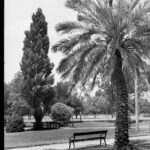

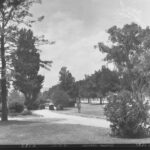
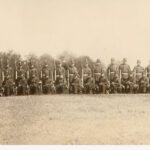

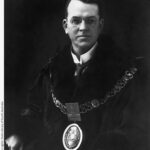
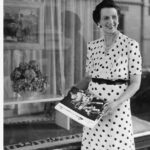
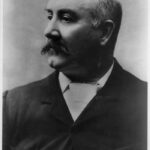
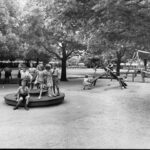
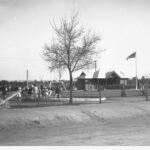
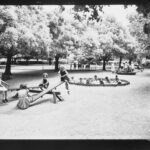

Comments